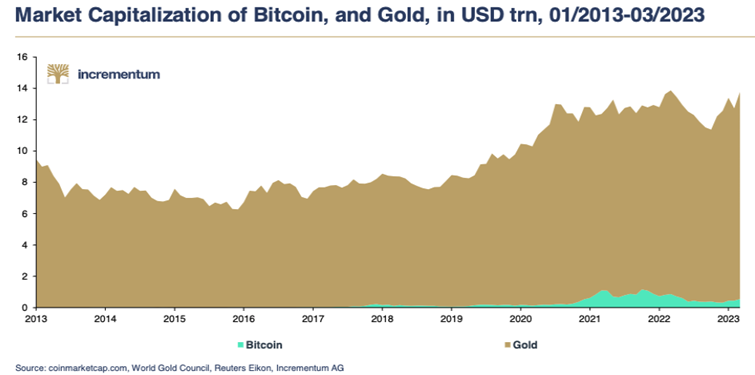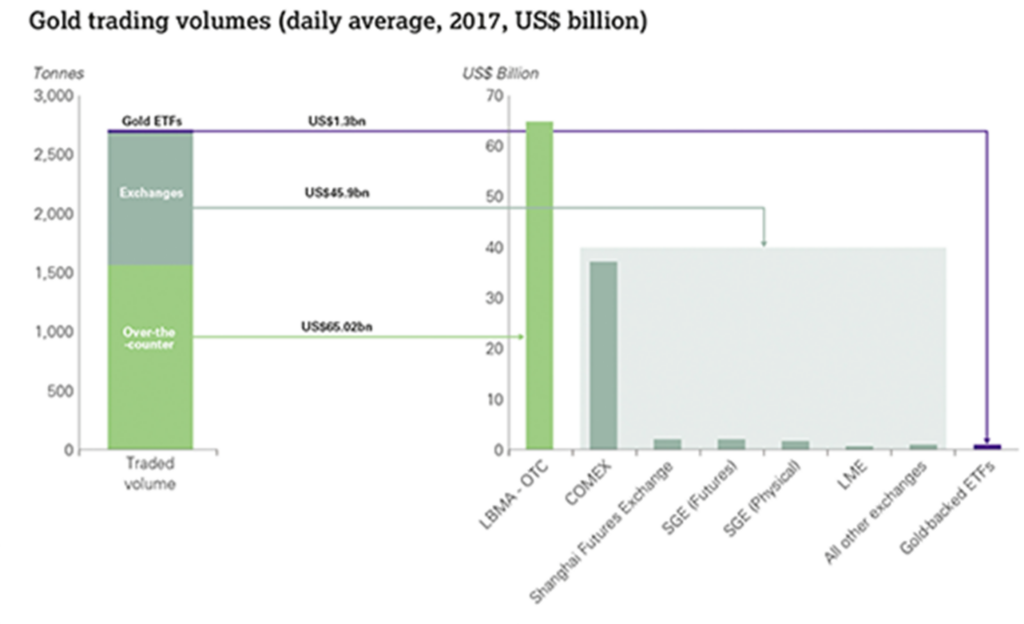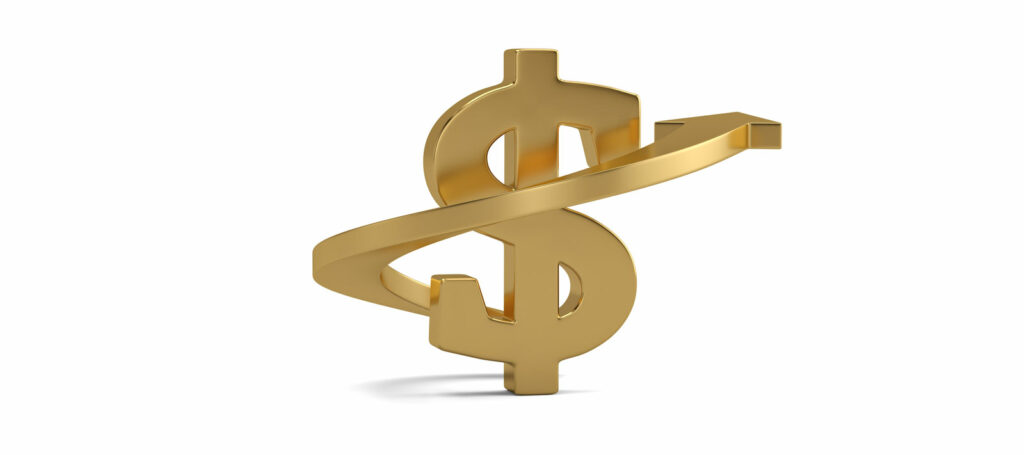For thousands of years, gold has captured the imagination of humans across the globe… and ruled the monetary affairs of modern civilizations.
Before the 20th century It was “the governor” of trade, prices and humanity’s most valued monetary asset.
No single human, committee or government designed this role for gold. It grew into this role slowly and steadily, across continents and through millenia.
Today, purely digital money reigns supreme. Major currencies like the dollar and euro are increasingly abstract; the vast majority of “our money” exists as purely digital information on commercial bank server farms.
But the speed and agility of “digital money” brings unseen danger: long term instability and the threat of systemic collapse.
While we won’t speculate on a near-term collapse of the modern monetary system, gold’s undying and near-universal appeal is for one reason; Because gold is essentially indestructible by conventional means, it has historically been the best way to store value across generations.
While you may already be convinced of this and other top reasons to invest in gold, there’s still one thing you need to keep in mind as an investor.
At the end of the day, it’s not just about adding gold to your portfolio, it’s adding the right type of gold investment for whatever strategy you’re pursuing. In this article, we’ve dive into the best gold to buy and everything you need to know to decide which type of gold investment suits you.
Key Takeaways:
- Why buy gold? The main reason to buy gold is because it fits into a broader portfolio strategy that helps you achieve your financial goals. However, as investors, the more obvious reason to buy anything is because you think the price will go up.
- What drives gold prices? Like every market, prices are set by supply and demand. However, because gold is not used for industrial purposes, it is far more sensitive to sentiment than utilitarian demand.
- Why buy gold now? There are at least three major catalysts forming that could drive the price of gold higher over the next three years – inflation, the reopening of China, and resource nationalism.
- What types of gold to buy? It all depends on your portfolio strategy! If you are looking for long term wealth preservation, physical gold often makes the most sense. If you are looking for a short term trading opportunity, gold ETFs (“paper gold”), gold miners, and royalty and streaming companies may provide you with more leverage.
Why Buy Gold?
The obvious reason why anyone would invest in gold is that they believe the price of gold is going to go up sometime in the next 1-5 years.
In fact, according to a recent poll by Gallup, for the first time since 2013, Americans think gold is a better long term investment than stocks and mutual funds.

Chart illustrating Americans’ perceptions of the best long-term investment. Source: Gallup
But at a more fundamental level, there are two different “roles” that gold can play in your portfolio – a defensive hedge against inflation and a store of value, or a speculative bet on the price movement of gold.
Regardless of the reason why you decide to buy gold, make sure it fits in with your broader portfolio construction, asset allocation model, and estate planning needs.
Gold as a Defensive Asset
If you are holding gold as a defensive asset, the idea is that gold at least maintains value, if not increase to cover losses in other parts of your portfolio.
For those buying gold as a part of a broader portfolio allocation model, according to Sprott, gold has proven its value as a safe haven asset during the seven crisis periods since 2007—returning 11.65% compared to -12.56% for the S&P 500 and 4.26% for U.S. Treasuries (as of 6/30/2023).

Performance of Gold Bullion vs. S&P 500 and U.S. Treasuries in “Crisis” Periods. Source: Sprott
Gold As A Speculative Asset
On the other hand, you might buy into the narrative that gold prices could shoot dramatically higher in the coming years due to the so-called Supercycle Thesis.
According to Goldman Sachs – and a growing chorus of other analysts – we could be looking at a once-in-a-generation bull market in the original source of all wealth… commodities. Just as commodity markets have been dominated by the dollar in 2022, Goldman Sachs analysts expect them to be shaped by underinvestment in 2023.
The rapid increase in the cost of capital reduces incentives to hold physical inventories or paper risk, leading to distorted price discovery as financial markets react faster than the real economy.
This creates markets that are simply unprepared for growth in 2023, setting the foundation for what’s known as a Supercycle; a “decades-long, above-trend movements in a wide range of base material prices” caused by a structural change in supply and demand.

Commodity prices – unlike financial markets – perform an economic function of balancing supply and demand. Once high prices have rebalanced the market in the short term, high prices are no longer needed, sending prices downward as we witnessed in late 2022. Source: Goldman Sachs
However, because the growing demand for base materials will likely outpace our current supply, the law of supply and demand points to one thing: prices must go up!
We’re already beginning to see confirmation of this trend as inflation roars, geopolitical conflicts flare, and rising interest rates put significant pressure on pretty much everything.

What Forces Drive Gold Prices?
The psychological and market mechanisms behind gold price movements have long been shrouded in mystery.
The Federal Reserve Bank of Chicago analyzed three major claims about what drives the price of gold. Their conclusions are instructive for anyone anticipating higher prices.
The three claims are:
1) Gold is an inflation hedge
As inflation rises, gold prices will likely rise along with it. This means gold acts as a “store of value” that protects purchasing power.

Gold has outperformed all major fiat currencies over time. Source: Gold.org
However, some investors don’t view gold prices as rising in dollar terms… but as dollars (or other fiat currencies) being devalued against gold.
2) Gold is sensitive to expected long-term real interest rates
Gold is typically compared and contrasted against bonds; Because gold has a carrying cost (i.e. the cost to store the asset), bonds that have yields greater than inflation (i.e. positive real yields) tend to be more attractive to investors.
As interest rates rise, bonds tend to become more attractive. Conversely, in a low interest rate environment with increasing inflation, gold tends to become a more attractive asset to hold.

Gold prices rise when real yields “go negative,” as in 2011-13, and in 2020. Image source
3) Gold is seen as protection against “bad economic times”
For whatever reason, gold is the “fear asset” of choice for many investors. When things go bad, gold becomes more attractive.
During the six crisis periods since 2007, gold has proven its value as a safe haven asset. On average, for the six periods, gold bullion has returned 13.45% compared to -15.68% for the S&P 500 Total Return Index and 6.31% for U.S. Treasuries (as of 12/31/2020).

Performance of Gold Bullion vs. S&P 500 Total Return Index and U.S. Treasuries in “Crisis” Periods (2007-December 31, 2020). Source
With gold industry insiders predicting much higher prices, it is no surprise to hear the World Gold Council call gold…
“The simplest investment for complex times”
If we take the Chicago Fed’s analysis at face value, it seems like the current macroenvironment shows a long-term bullish case for gold.
The simplest argument for a rising gold price is that there’s more demand than supply. The three claims that the Chicago Fed analyzed look to be in play. But in order to see any major price appreciation, we will likely need to see a catalyst ignite the demand for gold.
Why Buy Gold Now? 3 Potential Catalysts for Rising Gold Prices
In order to decide what type of gold you should buy, you first need to understand global factors and long-term trends that make gold an appealing investment.
The global gold market is gargantuan. If we look at the numbers, approximately 208,874 tonnes or a staggering 7,365,882,077 ounces of gold has been mined throughout history. And since the 1950s, we’ve seen the majority of this mining activity, approximately two-thirds to be precise. At the current spot price of approximately $2,000 per ounce, the value of above-ground gold sits at an impressive $14.73 trillion.

Market cap of Bitcoin & Gold. Source Incrementum.
Let’s delve a little further. The global scale of gold mining is truly awe-inspiring, with operations on every continent except Antarctica. It’s a diverse industry, with mines of varying types and scale.
However, even within this global spread, certain countries are prominent players. For instance, in 2020, China was the major player, accounting for around 11% of the total global production.

World gold production by country
Today, there are increasing geopolitical tensions, specifically relating to the Russia/Ukraine conflict and China’s dominance in the rare earth minerals market. These pressures could lead to a period of instability in the global supply chains for metals. As a result, we might see the emergence of new trading arrangements, particularly in North America (United States, Canada, Mexico).
The Demand for Gold
Gold is now bought by a far more diverse set of consumers and investors than at any previous time in history. In 2022, gold demand soared to 18% – an 11-year high – off the back of “colossal central bank purchases, aided by vigorous retail investor buying,” according to the World Gold Council.

Gold demand in 2022 is near a record. Source World Gold Council
Investment demand for gold increased by 10% to 1,107 tons, while holdings of gold ETFs saw smaller outflows in 2022 than in the previous year.
Jewelry consumption dropped 3% in 2022 to 2,086 tons, with much of the weakness concentrated in the fourth quarter as gold prices rallied.
The Supply of Gold
However, there is a severe shortage of new gold discoveries that threatens the long term supply.
According to Eric Saderholm, president of American Pacific Mining.
“I don’t see any major discoveries coming on. There were none in 2021 and very few smaller discoveries from 2020 to 2023. So it seems to be shaping up as a year where gold mining companies will exploit what they have if permitted and ready to go.
A lot of your [gold reserves] making a lot of money, regardless of the gold price, over the last 40 years have been mined out. Supply is not going to go up this year and production has gone down roughly 2% to 3% over the last decade.”
Prior to COVID-19, the mining sector was already struggling to cope with a decade of declining CapEx.

Recent CAPEX in metals and mining industries. Image source: Crescat Capital
Since gold exploration budgets have been steadily decreasing since 2012, Miners have been exhausting their existing reserves and resources. The small number of mines that can generate more than 10 million troy ounces – known as world-class deposits – are running dry…
And because of this large imbalance of “gold demand” vs “gold supply,” experts and analysts are sounding the alarm… The world is running out of new gold!
After a decade of disappointing price action in the gold markets, investors are starting to pile back into the yellow metal and prices are starting to rise.
According to S&P Global Market Intelligence (S&P), global exploration budgets rose 16% in 2022, following a 34% rebound in 2021. S&P added that while allocations for most commodities increased in 2022, budgets for gold and copper posted the largest dollar increases, while energy transition efforts saw lithium increase to its highest total ever.

What Type of Gold Can You Buy?
When it comes to gold investment, the market gives investors four main choices:
1. Paper Gold
Paper Gold is a combination of mutual funds and exchange traded funds (ETFs) – like GLD and AUD – along with gold futures and options in the commodities market.
Today, 92% of the world’s currency does not physically exist. Instead, the money we earn, spend and save, mostly exists as bits and bytes in purely digital ledgers. This means only 8% of our currencies are physical banknotes and coins.
The same thing is happening right now in the gold markets; The vast majority of investors who add gold to their portfolios, end up trading what is commonly called “Paper Gold” – A financial derivative that gives gold investors exposure to movements in the gold price, without owning the metal.

The majority of gold is traded via Exchange Traded Funds (ETF) – like GLD, or futures contracts – is purely abstract. Only a small portion of global gold trade is settled with physical delivery.
It is worth noting that Gold Futures serve a vital role in the industry. Gold futures derivatives markets attract many speculators, but it also allows mines, refineries, mints, dealers and consumers of gold to manage their risk.
Gold’s fluctuating price can be ‘de-risked’ by buying and selling Gold Futures Contracts. Gold suppliers buy “short” to lock in a selling price for their gold. Gold consumers can buy “long” to secure a purchase price for the commodity they need.
2. Physical Gold
Physical gold (also known as gold bullion) is the most direct way to gain exposure to gold. Gold bullion includes gold bars or gold coins (not gold jewelry), with its value being based on its mass and purity. One underrated, tax-advantaged way to hold gold bullion is through a Gold IRA (Individual Retirement Account).
Popular examples of gold coins include American Gold Eagle, the official gold bullion coin of the United States, and Canadian Maple Leaf, issued by the Royal Canadian Mint.
Today, 52% of demand for physical gold is the creation of jewelry. 27% of the demand comes from investors buying gold bars and coins, and 9% of demand comes from technology companies that require gold for their products.

Source: Goldman Sachs
When central banks, sovereign wealth funds, and family offices buy gold, they tend to favor buying physical bullion and vaulting it privately.
It is worth noting that there has been an increasing trend over the last decade for central banks to repatriate and store their gold domestically.
- At a press conference on January 16, 2013, the Bundesbank presented its new plans for the storage of Germany’s gold reserves. By 2020, the Bundesbank intends to store half of the country’s gold reserves in its own vaults in Frankfurt; the other half is to be stored in the vaults of its partner central banks in New York and London.
- France repatriated 221 tonnes of gold between 2013 and 2016, and all its monetary gold is now stored in La Souterraine in Paris.
- The Australian Reserve Bank sent an official to London to conduct an audit on their reserves that are kept in the vaults of the Bank of England in April in 2022.
- Other countries with notable repatriations over the last decade include Belgium, Switzerland, Austria, India, Mexico, Thailand, Sri Lanka, Bolivia and Bangladesh.
- China and Russia vault all their gold locally.
According to a June 2021 survey by the World Gold Council
“21% of central banks intend to increase their gold reserves over the next 12 months. Central banks are also increasingly valuing gold’s performance during periods of crisis as this attribute now tops their rationale for holding gold.
These results come amidst ongoing uncertainty stemming from the COVID-19 pandemic, a situation which has added significant complexity to central bank reserve management.”
Additionally, the US/EU’s 2022 sanctions against Russia – namely, freezing all dollar and euro demoninated foreign reserves – will likely continue to drive demand for physical gold for central banks.
3. Gold Mining & Exploration Companies
These are companies whose primary business is extracting precious metals from the earth.
Gold mines produce rough “dore bars” which are around 80 percent pure gold. These bars are sent to refineries, and turned into bars of gold with different shapes, weights, and purity.
Up to this point, the gold is typically owned by the mining company or the mine’s financiers.
Once refined, ownership of the gold is usually transferred to bullion banks, who take delivery and distribute the gold bars to vaults and customers around the world.
Junior mining companies are often seen as an extremely speculative play with high rates of failure. Major mining companies – like major tech companies – are the stalwarts of the industry that have persisted over the decades.
Popular gold mining stocks include Barrick Gold (GOLD), Franco-Nevada (FNV) and Newmont Corporation (NEM).
Finally, there’s a fourth – and little talked about – way to play rising gold prices.
4. Royalty & Streaming (R&S) Companies
R&S is a unique financing vehicle that gives investors an opportunity for downside protection, cash flow, and speculative upside on the price of gold. Here’s how it works.
R&S companies create shareholder value by offering an alternative financing agreement to junior mining companies that guarantee the rights to future cash flows or metals production.
As long as the mine is producing, investors are entitled to a portion of either the revenue generated by the company (a royalty)… or the actual metal production at a discounted price (a stream).

Generally speaking, royalties are created when a junior explorer needs money to continue exploring his land package. Streams are created when a mine developer needs to raise capital to build a mine.
In other words, it doesn’t matter if the mine is profitable or not. As long as gold is being mined, investors who own shares in Royalty & Streaming companies Golden still get paid.
For investors looking for a way to turn a small bet on gold prices going higher into potentially extraordinary gains, you might consider buying junior mining stocks, gold futures and options contracts, or royalty & streaming (R&S) companies. But each vehicle has its risks.

Risk increases when speculating on gold price movements
Futures and options can be complicated and extremely risky for investors who do not have a deep understanding of the derivatives markets. And while mining stocks may appear to be surging, they tend to be far more volatile than most investors can stomach.
R&S companies may offer investors new and compelling opportunities: the downside protection of physical gold, the predictable cash flow of real estate, and the upside potential of technology stocks.
For this reason, we consider R&S companies one of the best ways to speculate on rising gold prices. However, any investment should be considered high-risk and speculative in nature. Please do your own due diligence.
Want to learn more about investing in gold and private market deals?
Here at Equifund, we help investors access early-stage opportunities not found anywhere else. To view our current listings, go here now.
P.S. Equifund just launched its latest Regulation A+ offering for an already-publicly-traded gold royalty and streaming company.






